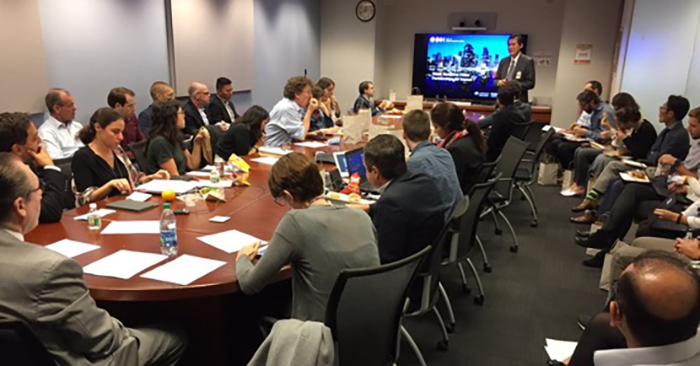CRCWSC boosts international awareness of water sensitive cities
Boosting visibility and understanding of water sensitive cities came to the fore recently for the CRC for Water Sensitive Cities (CRCWSC). A series of international meetings saw Chief Executive, Professor Tony Wong, lay groundwork for future collaborations that could open doors for commercial and partnership prospects for Australian organisations, secure future funding for research, profile the achievements of its partner organisations, and see greater uptake of water sensitive cities and their potential to deliver better human and environmental health.
Introducing the work of the CRCWSC and the water sensitive cities concept to new places and new problems was a recurring theme.
In the desert city of Hotan, China, Professor Wong was invited by the Asian Development Bank to introduce the water sensitive cities concept to an arid context. For most of the year, Hotan relies on groundwater that is progressively contaminated by urban pollution and agricultural/aquacultural activities. While places like Israel have provided global inspiration for how to use water in smarter, more innovative ways by embracing innovative water recycling, the more holistic approach of becoming water sensitive in a desert is a more open question.

The prospect of Managed Aquifer Recharge with snowmelt water and net zero wastewater discharge plus other source controls of groundwater contamination, are some of the elements that could yield a water sensitive Hotan.
Washington DC was also a site for first introductions in the CRCWSC’s meeting with the World Bank. Updates on the CRCWSC’s work resonated through sections of that organisation when Chief Operating and Finance Officer, Ben Furmage, presented the inaugural think tank paper “Water Utilities of the Future: Australia’s experience in starting the transition” at the 2017 Stockholm International Water Week.
“The Water Sensitive Cities Index and the concept of leapfrogging were of specific interest for the Bank,” said Professor Wong. Discussions on leapfrogging included the potential of water sensitive thinking in two major areas: helping cities to recover after a natural disaster, and in rebuilding them after war – an area also of interest for the United Nations. The CRCWSC’s continued development of its Water Sensitive Cities Index generated substantial interest, strengthened by clear alignment with the United Nations’ Sustainable Development Goals.
#Water&Health2017 at @UNC we convened a successful side meeting on #RISE with key stakeholders incl @WHO @UNICEF @gatesfoundation @USAID pic.twitter.com/6Uuyazhrl0
— Tony Wong, CRCWSC (@tonywong_crc) October 20, 2017
Prof. @tonywong_crc: ADB can lead cities to think about conservation of natural capital, nature-based solutions pic.twitter.com/ArQzFfLxuo
— ADB Environment TG (@ADBEnvironment) October 25, 2017
We hope the beginning of a new partnership with @WorldBank to help transition & #leapfrogging global cities to #watersensitivecities https://t.co/Ya53fdUITM
— Tony Wong, CRCWSC (@tonywong_crc) October 20, 2017
In other locations, it was new problems and “markets” for water sensitive thinking that featured.
The CRCWSC provided a presence at the 2017 Water and Health Conference, where the Water, Sanitation and Hygiene sector attracts major philanthropic organisations; delegates to the conference included representatives of USAID, the Bill and Melinda Gates Foundation, the World Health Organisation, UNICEF, and the World Bank.
This sector spends a striking US$10 billion on health interventions every year, with a slight majority invested in rural and remote communities. But servicing cities and towns is an emerging focus, and introducing the potential applications of water sensitive cities for aid purposes comes off the back of Revitalising Informal Settlements and their Environments (RISE): a Monash University-led project with the Asian Development Bank that will measure how water sensitive thinking could improve conditions in informal settlements, together with partners including Melbourne Water and South East Water.
“The RISE program will use context-specific water sensitive approaches to deliver improved public health – the thinking and technologies are applicable for many unserviced and informal urban areas,” explained Kerrie Burge, CRCWSC International Engagement Manager for the Asia-Pacific. “It was great to attend the conference and discuss the upcoming research outputs from RISE with some of the key stakeholders involved in delivering water and sanitation in developing cities” she said.
The pair’s travels also saw them help run a course on nature-based solutions for the Asian Development Bank, providing training for that organisation’s key on-ground change-agents: its project officers.
“Connecting with new potential collaborators is important, not only for continuing to grow awareness of water sensitive cities, but to lay pathways for future investments, partnership projects and commercial opportunities for the CRCWSC and its partners at home,” said Professor Wong. “Projects overseas are also invaluable because they provide the chance to test and scale up insights in ways not always possible at home. We can then bring the benefit of those experiences back to Australia and our partners.”
Hot on the heels of this visibility tour is a recent visit to China by Victorian Water Minister, the Hon. Lisa Neville, to continue cementing water sensitive cities/sponge cities collaboration between the sister states of Victoria and Jiangsu Province, and to inspect the site of the Victoria-Jiangsu Innovation Park for demonstrating water sensitive cities technologies. There, the profile of the CRCWSC’s work, and its achievements in partnerships with its Australian partners, have led to commercial outcomes for local partners now working in China to help deliver water sensitive projects.